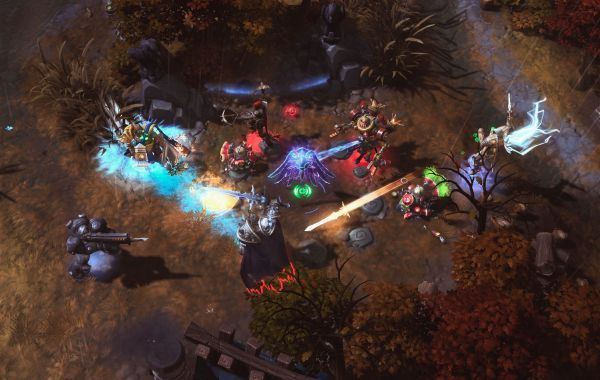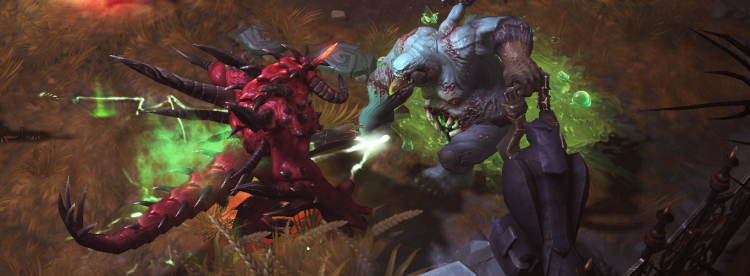
Starcraft: Brood War is celebrated as one of the greatest competitive games ever, but many of the custom maps derived from it happily stripped away the complexity in search of a new type of gameplay. Aeon of Strife was one of those maps, removing not only base building but the entire RTS element of the game in order to create something much closer to an Action RPG. In hindsight there was something about Blizzard’s map editor, with its definitive square shape that invited cutting it into half, and the opposite halves themselves looked primed to represent opposing sides. Most of that space, however, wasn’t used. The action happened in the lanes.
It was the crudest kind of map design, slicing three straight paths towards the enemy and populating them with waves of AI controlled units: tug of war with a twist. Aeon of Strife came back in Warcraft III, but the newer game delivered a more powerful map maker, so the features that custom maps enjoyed were consequently more robust. Defence of the Ancients was one of the native Warcraft III mods inspired by Aeon of Strife, and, as we know, it was the one that took off in a big way.
In a kind of weird feedback loop, when Starcraft 2 shipped it was with promises of new, Blizzard designed custom maps. One of them was Blizzard Dota, a Starcraft-based spinoff of the moba genre featuring heroes from the entire Blizzard multiverse. But while other promised mods shipped, the now renamed Blizzard Allstars stayed off the radar, until it resurfaced as a stand alone game, Heroes of the Storm (Heroes).
Heroes takes a lot from League of Legends. There’s the same microtransaction model of purchasing heroes and skins in addition to unlocking them through ingame currency. The two games even have the same slow rhythm, with heroes and abilities that bring out fights that happen in close quarters, and move slowly. They feel similar, but Heroes has done some major restructuring.
 For one, a shift in philosophy has occurred: Heroes aims to deliver brief, deathmatch-style gameplay that is quick and fun and doesn’t lock down players for thirty minutes or more. In contrast with the slow, grindy style of other mobas, you don’t have to farm gold, playing passively while you reach your economic sweet spot, whereupon you can tackle the enemy team. Instead, you start with all your abilities, a variety of objectives giving you reason to use them. Heroes features small maps where lanes are so short the enemy bases are practically door to door, but you don’t spend that much time trying to control the lane. Instead, the space around the lane is incentivized. You don’t move diagonally, corner to corner, but go in a circle, from objective to objective. Blizzard calls this kind of game a “hero brawler,” with obvious emphasis on the action element that early mobas enshrined.
For one, a shift in philosophy has occurred: Heroes aims to deliver brief, deathmatch-style gameplay that is quick and fun and doesn’t lock down players for thirty minutes or more. In contrast with the slow, grindy style of other mobas, you don’t have to farm gold, playing passively while you reach your economic sweet spot, whereupon you can tackle the enemy team. Instead, you start with all your abilities, a variety of objectives giving you reason to use them. Heroes features small maps where lanes are so short the enemy bases are practically door to door, but you don’t spend that much time trying to control the lane. Instead, the space around the lane is incentivized. You don’t move diagonally, corner to corner, but go in a circle, from objective to objective. Blizzard calls this kind of game a “hero brawler,” with obvious emphasis on the action element that early mobas enshrined.
While Heroes looks like a natural evolution of the moba model, and still feels like one to an extent, it’s supposed to be a different type of game: faster, leaner, less organic. Paradoxically, the lanes are the one weird element of the game. Normally the pillars of the moba playstyle, here they look tacked on, in the way. With their commitment to a fast and fun style of game, why doesn’t Blizzard just remove the lanes altogether, using that space to expand the objectives?
First, understand that lanes are intrinsically tied to the economic element of mobas. The creep waves pushing back and forth aren’t just there for show: they’re food. The entire early game is about securing some kind of economic standing, either starving your opponent, becoming richer than them, or just getting enough gold for your hero lineup to come online.
Second, lanes are objectives in themselves, and they open the way to other objectives. They are not just physical paths, but the structure of the game from start to finish. A lane that is pushed too far can threaten a tower, so heroes are drawn back to defend it, thus giving space to the enemy team. A lone hero pushing or defending that same position can be the bait or space-provider needed to secure an advantage like LoL’s Dragon or Dota’s Roshan. Since lanes are the paths that lead to the enemy base, the greater distance you control, the easier it is to control the map itself, making it harder and harder for the other team to move, farm, and feel safe.
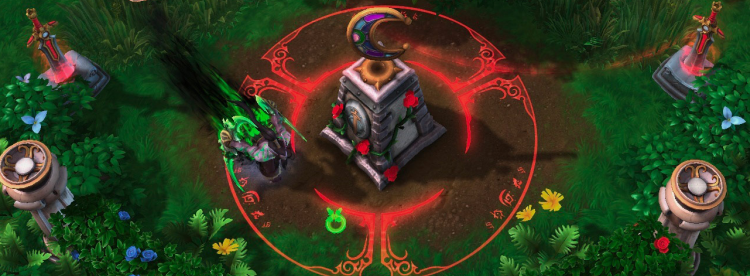
One of Heroes’ main features is actually the lack of one: there’s no itemization. You don’t save up gold and buy items. Your supports don’t have to get wards; your carries don’t start out useless. But with no itemization, there’s no need for an economy, so why do lanes still exist? While farming a lane has little purpose in Heroes -- you can get the same amount of XP fighting enemy heroes -- the creep armies pushing them can still harm your base, which means you still have to periodically move back to the lane and defend it, or otherwise try to push into the enemy base. The lane still supplies half its purpose: it’s just another kind of objective, supplying direction, yet overlapping with the main attractions. The lane is the final vestige of a system that Heroes is trying to revamp for a different type of player
In traditional mobas the economy is slow. It can take anywhere from twenty to thirty minutes for a carry to achieve optimal farm status, while supports usually starve. Blizzard, however, wants to speed up the game by creating objectives and weak defenses (towers even run out of ammo). Both move the game forward while keeping players out of the lane. Why? The lane is the place you grind in order to obtain an object that allows you to have fun. You don't want to be there. You want to run around using your abilities. It’s normal for other players to complain that a carry is farming too much, not fighting with the team, or that they have not farmed well enough, and is therefore ineffective. This will never happen in Heroes, where the only way be “ineffective” is to be a poor decision maker.
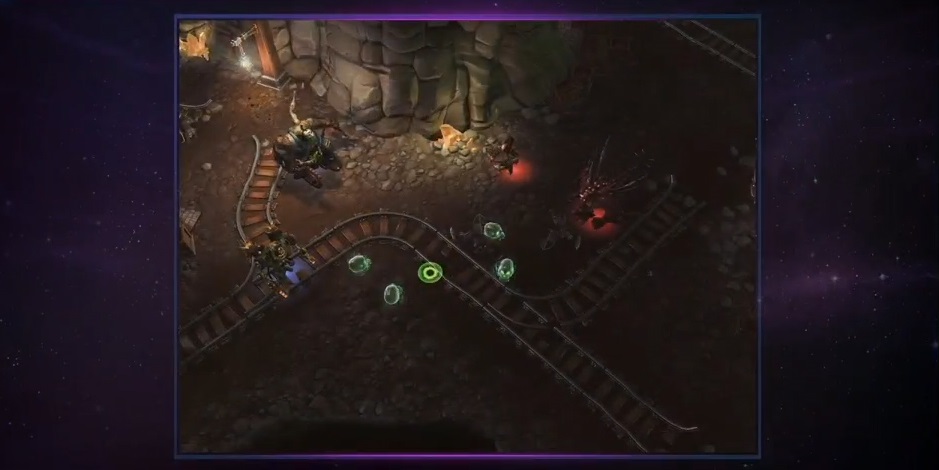
Haunted Mines is an example of bold game design in MOBAs where for periods of time, battles are waged on two different maps at the same time
Objectives already move players out of lane. The Haunted Mines level, for instance, actually takes players to a different map altogether. Similarly, the Dragon Shrines and the Raven Lord can provide such devastating advantages that winning the game can depend entirely on how many times you obtain that particular advantage. The objective is king, but not king enough. Blizzard should push this further and create entirely objective based play, rather than lane based play.
 In LoL everybody starts weak because the economy provides a model of ingame progression. If you start slow, you become fast; if you start weak, you become tough. Blizzard has already intuited this by having every hero start with all their abilities minus the ultimate. In Dota, players usually avoid aggression until they gain a few levels because most of the time they simply lack the firepower to secure a kill. Not so in Heroes: you can start fighting from level 1, and due to your scaling abilities, you can expect to be as effective as later in the game. Not only that: experience is shared, so there’s no reason to avoid fighting in packs for fear that you’ll remain underleveled as experience is gobbled up by your allies.
In LoL everybody starts weak because the economy provides a model of ingame progression. If you start slow, you become fast; if you start weak, you become tough. Blizzard has already intuited this by having every hero start with all their abilities minus the ultimate. In Dota, players usually avoid aggression until they gain a few levels because most of the time they simply lack the firepower to secure a kill. Not so in Heroes: you can start fighting from level 1, and due to your scaling abilities, you can expect to be as effective as later in the game. Not only that: experience is shared, so there’s no reason to avoid fighting in packs for fear that you’ll remain underleveled as experience is gobbled up by your allies.
The economy (of gold and of XP) plays a huge roll in how players differentiate from one another: faster farmers get better items more quickly. They gain an advantage that becomes physical and experiential, increasing the gap between one team and the other. Teams don't fight on an even footing, and your opponent can reach an advantage that effectively nullifies the thing that makes playing your hero so fun. But Heroes has no economy, so that model of progression is pointless: you can be tough, fast and deadly from the get go. Another advantage is that the game never stops being a contest. You have to fail quite spectacularly for you not to achieve that minimum of XP that keeps you in range of your opponent.
WoW has the right idea. In the past your Arena performance was contingent on having gear that stood up to your opponent's gear, but Warlords of Draenor wants to level the gear requirement and make sure players can depend solely on their own skill. It seems to me Heroes is even more attuned to that ideal. In Heroes the only intrinsic advantage you can gain over an enemy is XP, and judging by what I’ve seen of the alpha so far, that’s hard to achieve. The result is that players will spend more time on even footing. But be careful: that doesn’t mean a low skillcap, because skill doesn’t lie in acquiring farm, but in securing objectives. Imagine if getting Baron resulted in him following you around for a minute. How would the game change then? Gameplay in Heroes is all about getting the objective. Playing positionally, understanding your strengths in a teamfight, and using your skills effectively are the keys to a good experience in Heroes.
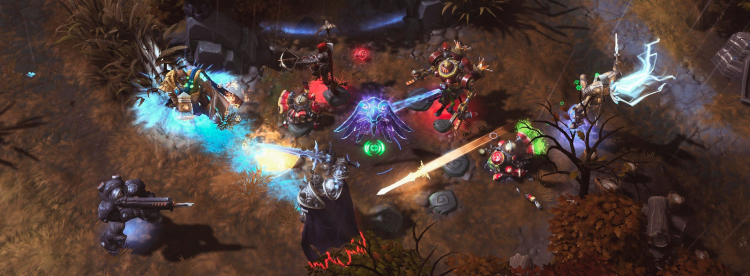
Despite these many differences, people will treat Heroes like any other moba. Blizzard devs have already stated that they don't think of it as such, instead referring to the game as a “hero brawler.” That's fine, but the game still looks too much like a moba, which will invite comparisons to the far more entrenched LoL and Dota 2. Getting rid of lanes and the traditional base defense layout will go a long way to cementing Heroes’ distinct personality. Notice that farming creeps isn't exciting, but hitting them over and over again is the same as farming, only you get XP instead of gold. It’s actually less rewarding and more tedious than last hitting. This is at least one respect Heroes would benefit from by removing lanes. Once you get rid of the lane, you can go down any number of gameplay paths.
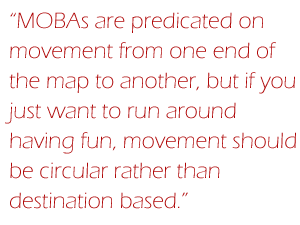 Just as Warcraft 3 simplified Diablo's huge skill trees into a handful of abilities per hero, but inserting these heroes into a complex real time strategy environment, Heroes melts down the economic element in the search for a faster, leaner incarnation of the moba, one in which you have no downtime, no periods of idle farming. Perhaps the best way to think of Heroes is as a battleground from WoW, a pocket universe focusing on intense moment-to-moment action on a large scale. Sure, a battleground on its own is a much simplified version of the giant that is WoW, but if the place accomplishes its purpose, why would that be a bad thing? Battlegrounds, through their objectives and level design, test players in a way another player can’t.
Just as Warcraft 3 simplified Diablo's huge skill trees into a handful of abilities per hero, but inserting these heroes into a complex real time strategy environment, Heroes melts down the economic element in the search for a faster, leaner incarnation of the moba, one in which you have no downtime, no periods of idle farming. Perhaps the best way to think of Heroes is as a battleground from WoW, a pocket universe focusing on intense moment-to-moment action on a large scale. Sure, a battleground on its own is a much simplified version of the giant that is WoW, but if the place accomplishes its purpose, why would that be a bad thing? Battlegrounds, through their objectives and level design, test players in a way another player can’t.
Mobas are predicated on movement from one end of the map from another, but if you just want to run around having fun, movement should be circular rather than destination based. Yet again another game understood this principle: Dawn of War 2 strips most of its predecessor’s economic elements and instead has players skirmishing around a wide variety of objectives. It recognized that its RTS elements were run-of-the-mill, and decided to embrace ideas that were pure Warhammer. DoW2 has no bases to destroy, no lanes to control. In spite of that, it remains a very fun game.
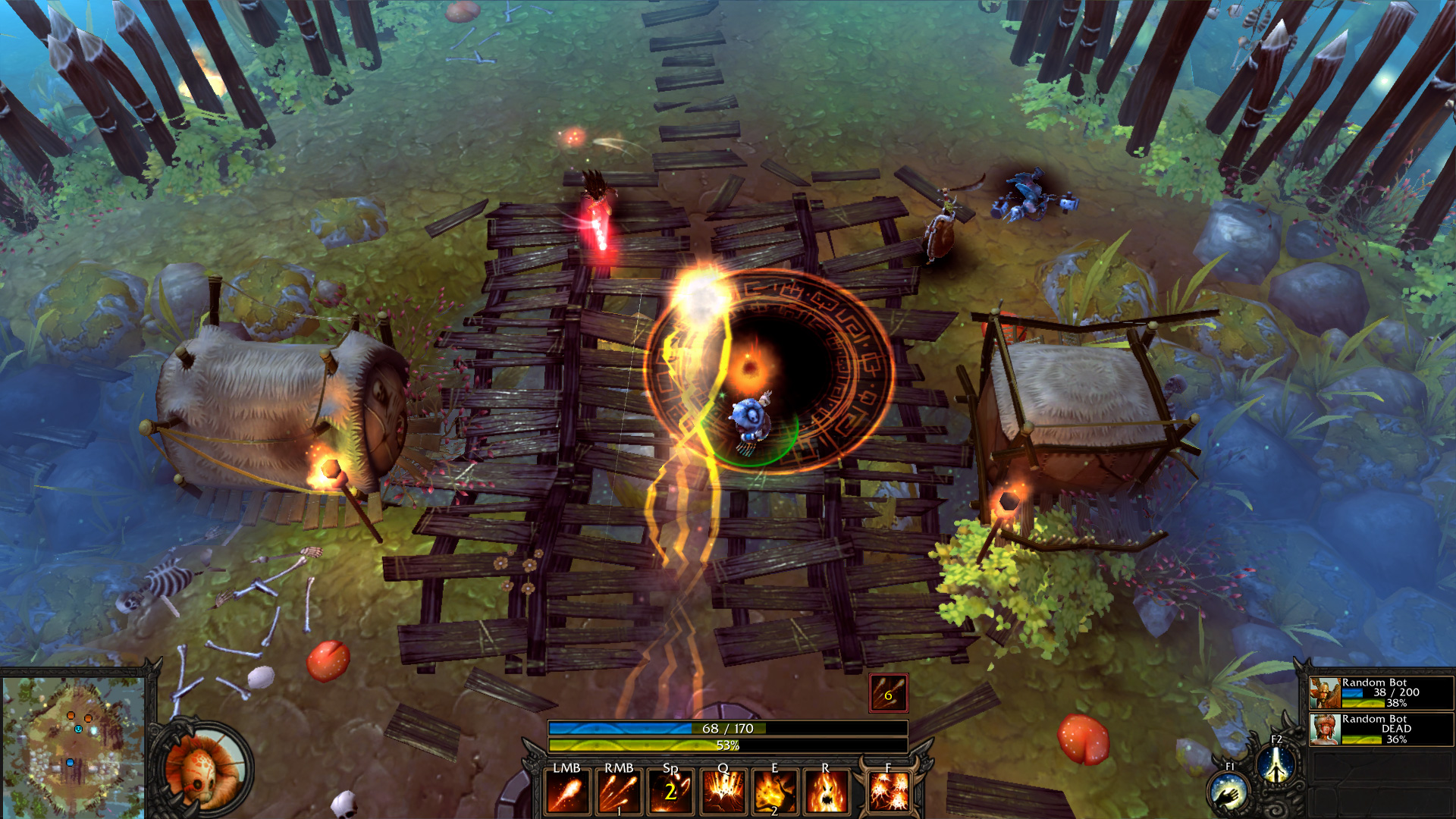
Lack of lanes in hero brawlers didn't really work out for Bloodline: Champions
Granted, in the short run removing the lanes may create more trouble than it's worth. One shouldn't underestimate the effect they have on a player's sense of direction and purpose. They act like huge double headed arrows, obvious cues to how the game is meant to be played. A pure objective based game is more dynamic, but less intuitive. In addition, if the lanes go, everything tied into them has to change. Lane creeps need to be re-purposed, neutral creep camp behavior has to be altered, base defenses must be moved around to accommodate the new layout. By all accounts, it would be a bold move. Blizzard has refined the art of refining already existing styles and genres into more palatable forms, but the company hasn't broken new ground since Warcraft 3 more than ten years ago. The safe option is to stay the course, the risk being to flounder in a market already being attacked from every direction by titles such as Smite, Dawngate, and Infinite Crisis. On the other hand, if you take the gamble and go without lanes, you approach something like Bloodline Champions, and we all know how that worked out.
 There's another question: the feasibility of major reworks at this point. Although Heroes has been introduced as an alpha, it still shipped with a polish and readiness approaching that of Starcraft 2's beta, complete with a working store. It's safe to conjecture that we're not dealing with a traditional alpha so much as a retread of Hearthstone's release history. It's worth noting that Hearthstone itself anticipated the elements we're now seeing in Heroes: short matches, simple but challenging play, a unique charm, and most of all, great polish. It's for this reason above all others that Blizzard would stop from introducing any major changes into the game.
There's another question: the feasibility of major reworks at this point. Although Heroes has been introduced as an alpha, it still shipped with a polish and readiness approaching that of Starcraft 2's beta, complete with a working store. It's safe to conjecture that we're not dealing with a traditional alpha so much as a retread of Hearthstone's release history. It's worth noting that Hearthstone itself anticipated the elements we're now seeing in Heroes: short matches, simple but challenging play, a unique charm, and most of all, great polish. It's for this reason above all others that Blizzard would stop from introducing any major changes into the game.
Depending on how the community responds to Heroes, a rework of this scale could still be feasible. What can you do if you get rid of lanes? Well, anything. Heroes is shaping up to be a distillation of familiar elements, but it can go into much more different, far wider directions. Just as Warcraft 3 and Dawn of War 2 gave a new spin on the RTS, becoming highly respected competitive games, so can Heroes find its own spirit, its own unique character, that will make it neither LoL nor Dota, but something different: a true contender.

